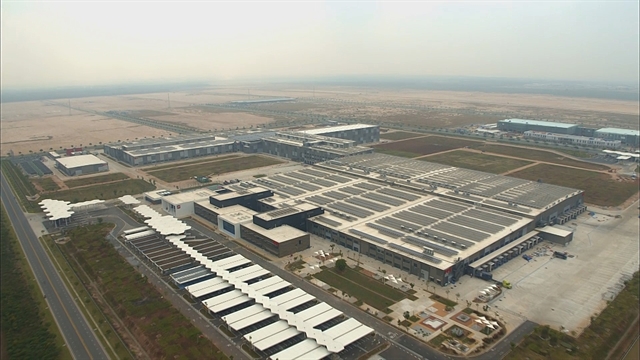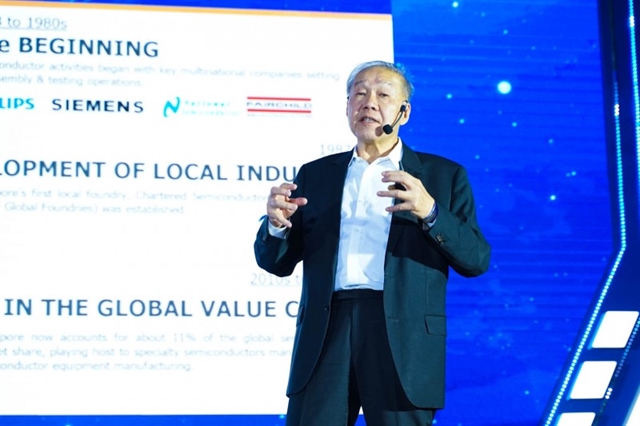 Economy
Economy

 |
| Panelists at a symposium, entitled “Semiconductors Unleashed: The Backbone of Modern Innovation,” on December 18 in Hà Nội. — Photo courtesy of VinFuture organiser |
By Thanh Hải
HÀ NỘI — Future of the global semiconductor industry was the main topic of discussion at a symposium, entitled “Semiconductors Unleashed: The Backbone of Modern Innovation,” on December 18.
The event is part of the symposium series "Science for Life" within the framework of VinFuture Science and Technology Week 2023, taking place in Hà Nội from December 18 to 19.
The international forum brought together many leading scientists and domestic researchers to connect and discuss the future of the booming global semiconductor industry.
Participants heard that as the "lifeblood" of the digital economy, the semiconductor industry is forecast to bring in revenue of more than US$620 billion by 2024 and increase sharply to $1 trillion by 2030, according to the consulting and research company Gartner. The semiconductor industry is also considered a core part of the technological competition between great powers in the 21st century.
Prof. Richard Henry Friend from Cambridge University (UK), Chair of the VinFuture Prize Council, emphasised that semiconductors are the foundation technology of many current technology solutions. Everything from energy systems to telecommunications and computing requires semiconductors. Semiconductors play an important role in development and it is opening up many opportunities and attracting many industries.
Prof. Teck-Seng Low, Senior Vice President at the National University of Singapore predicted that semiconductor technology will be the "backbone" of developing many industries as well as attracting talent to countries.
Currently, according to Prof. Low, around the world, there is a race to reduce the size of semiconductor chips. Chips have been produced in decreasing sizes from 9nm, 7nm, 5nm, and 3nm. Chips are getting smaller and smaller, and are expected to dominate and improve even more areas of life.
The microelectronics and semiconductor industry currently contributes 9 per cent of Singapore's GDP and 42 per cent of total manufacturing outputs. Lessons from Singapore can be applied to development strategies in many countries around the world, including Việt Nam, according to Prof. Low.
 |
| Prof. Teck-Seng Low, Senior Vice President at the National University of Singapore speaks at the event. — Photo courtesy of VinFuture organiser |
Prof. Low said Singapore copied the semiconductor technology model of Taiwan (China). Singapore did not use much government budget, but this capital source was a good primer for attracting leading semiconductor companies to Singapore. Singapore also has policies to attract investors.
To develop this industry, Low suggested, it is necessary to attract foreign investors and secondly, develop domestic semiconductor companies, combining internal strength and foreign investors.
Lessons for Việt Nam
Việt Nam has had nearly 10 years of research on semiconductor chips but has not achieved the expected results. Prof. Low suggested that Việt Nam can start like Singapore, by investing in Lab rooms. This investment requires millions of US dollars.
“Every year, Singapore spends $5 billion on research, but this money will be useless if we do not have talented human resources to develop. Therefore, the strategy to attract good human resources in the field of semiconductors is a prerequisite when you want to start developing this technology industry," said Prof. Low.
Emphasising the importance of financial and human resources in semiconductor development, Prof. Low said that Việt Nam can look at Singapore because starting a Lab requires tens of millions of US dollars. Việt Nam can start with a reasonable initial cost when cooperating with a startup model.
Prof. Vivian Yam - a member of the VinFuture Award Preliminary Council - also believed that Việt Nam can start on a small scale such as investing in universities to promote research and training. Universities will create high-quality human resources for the semiconductor industry.
According to Dr. Sadasivan Shankar, Research Technology Manager at SLAC National Laboratory in Stanford University, USA, the $600 billion electronics industry is mostly focused on computing and services. Participating countries should start from a small scale to gradually develop their capacity.
Dr. Shankar believes that developing countries like Việt Nam can establish programmes or funding options to promote education. Chip packaging is a great opportunity for Việt Nam to grasp.
Answering the question of what Việt Nam needs to do to develop the semiconductor industry, Professor Nguyễn Thục Quyên, California University, Santa Barbara (USA), Co-Chairman of the VinFuture Award Preliminary Council, said that universities need to train high-quality human resources for semiconductors, training students to both study and practice at businesses.
“Việt Nam is lacking this high human resource. Việt Nam is a developing country that needs shared infrastructure, which is important to attract investors," said Prof. Quyên. — VNS




